World Nutrition
Volume 2, Number 1, January 2011
Journal of the World Public Health Nutrition Association
Published monthly at www.wphna.org
The Association is an affiliated body of the International Union of Nutritional Sciences For membership and for other contributions, news, columns and services, go to: www.wphna.org
Commentary. The big issue is ultra-processing
‘Food guide pyramids’, and
what’s the problem with bread

Carlos Monteiro
Centre for Epidemiological Studies in Health and Nutrition
University of São Paulo, Brazil. Email: carlosam@usp.br
Biography posted at www.wphna.org
Introduction

Editor’s note
This second commentary on ultra-processed foods published this month focuses on two more issues that follow from Carlos Monteiro’s initial commentary in the November issue of WN. The first is the ‘Food Guide Pyramid’, now a standard guide to what is supposed to be healthy food and nutrition, at first in the US, and then in many countries. The second is bread. Some readers have been surprised to see that bread is classified as an ultra-processed product (UPP)
Food and nutrition interest practically all people, at least at some time in their lives. Parents naturally care about what their children eat. Much food aid is designed as a response to ‘classic’ malnutrition, meaning undernutrition and even hunger and starvation, which remain common in many impoverished parts of the world. It is now well known that unhealthy diets are a cause of obesity and also of diseases such as diabetes, heart disease and some major cancers, which at global level continue to become more common. So nutrition is important, and most people know this.
In response, for many decades United Nations agencies, national governments, authoritative health and medical organisations, and nutrition scientists, have made recommendations about overall diets generally agreed to be healthy, and also about specific types of food identified as healthy. The general recommendations are often in the form of ‘food guides’ shown graphically. These may be in the form of plates, or wheels, or pots, or rainbows, but ‘the Food Guide Pyramid’, originated in the US and now adopted or adapted in many countries, is now the most powerful and common.
Specific recommendations issued in the last half-century almost always recommend that the bulk of all types of diet should come from starchy foods, meaning foods that are mainly or largely made from cereals (grains) and their products, and also from starchy roots and tubers. Of such foods, bread is almost always seen as a staple food, and as such is featured in the bottom sections of Food Guide Pyramids, which identify and show foods recommended to be consumed in abundance. In effect, what the Pyramids say, for almost all people, is: Eat more bread, and more of other starchy foods and other cereal products. As you will see here, this category also includes pasta, buns, and even some fatty or sugary or salty products such as cup-cakes and crackers.
These general and specific recommendations may be having an effect on public health, but it is hard to say that any such effect is proving to be beneficial. It is true that rates of death from cardiovascular disease have dropped rapidly in many higher-income countries. (Whether this is mainly because of changed diets, or because of improved medical and surgical intervention, is debated). But rates of cardiovascular disease are rising rapidly in many low-income countries, and rates of obesity and diabetes are rising rapidly in most countries.
Take as one example, rates of overweight and obesity in my own country of Brazil. Results of nationwide surveys conducted between 2003 and 2009 show dramatic increases (1). Overweight in adolescent boys has, in just six years, increased from 17 to 22 per cent, and in girls from 15 to 19 per cent. In the same period, adult overweight has increased from 41 to 50 per cent in men, and from 41 to 48 per cent in women. That is to say, in Brazil now, one fifth of all adolescents, and practically one half of all adults, are overweight. This rapid trend suggests that in 10 or 15 years’ time, overweight and obesity will be as widespread in Brazil as it now is in the US, where one-third of all adolescents and two-thirds of all adults are overweight. Even more troublesome is that in Brazil now, around one-third of all children aged 5-9 are overweight, about the same as in the US.
One reason for this is no doubt the increase in the use of motorised transport and of computers and electronic games. But most independent researchers would surely say that the main single reason is the rapid change in food systems and dietary patterns. Specifically this has resulted in much greater consumption of what I and my colleagues term ‘ultra-processed’ energy-dense, ‘fast’, convenient, ready-to-eat and ready-to-heat fatty or sugary or salty snacks, foods, drinks and meals, and also sugary drinks.
Without current dietary recommendations, which include the Food Guide Pyramid and also promotion of bread, would rates of obesity in Brazil and in many other countries now, be worse? I doubt this. After many years of accepting the usual view, and after new examinations of the evidence with my colleagues at the school of public health at the University of São Paulo, I now have a different opinion. I conclude that the Food Guide Pyramid as usually constructed, and the advice to consume a lot more starchy food almost irrespective of its nature, including ultra-processed products (UPPs) such as bread, are not part of the solution. They are part of the problem.
This and my previous commentaries include only a few references. They could be copiously referenced. But I think there is no need. Almost all the points made derive from standard texts and references and other well-known sources, readily accessible on the internet by using Google or other search engines. The new reasoning is my own, together with that of my colleagues.
Box 1
Processing: My view
To repeat what I said in my first commentary published last November and in papers published elsewhere (2,3), food processing as such is not the issue. Much writing that criticises food processing makes little sense. Practically all food and drink is processed in some sense. Various forms of processing are neutral or benign in their effects. Many foodstuffs as found in nature are unpalatable or inedible, and some are toxic, unless prepared or cooked. Further, all perishable foods, unless consumed promptly, need to be preserved in some way.
The issue is not food processing in general. It is the nature, extent, and purpose, of processing. More generally, the issue is the proportion of meals, dishes, foods, drinks, and snacks within food systems, in supermarkets, and therefore in diets, that are ‘ultra-processed’. These characteristically are ready-to-eat or ready-to-heat ‘fast’ or ‘convenience’ products, most notably in the form of fatty or sugary or salty snacks and sugared drinks. These are best all seen as the same sort of ‘edible food-like substance’ or, as I call them, ‘ultra-processed products’ (UPPs).
The issue is also one of proportion. I do not say or imply, that the only healthy diets are those consisting solely or predominantly of unprocessed or minimally processed foods. Not at all. All cooked food is by any normal definition processed. Indeed, the basis of all traditional cuisines is whole or relatively unprocessed produce, made into meals and dishes with the use of processed ingredients including flours, fats, oils and sugars. The issue is ultra-processing. Ultra-processed products, including those that make or suggest health claims, are intrinsically unhealthy.
The public health problem caused by ultra-processing becomes evident and then an acute crisis, as the proportion of UPPs within food systems, food supplies and diets rises, as it rapidly has, and still is, throughout the world, especially since the 1980s. Ultra-processed products are rapidly becoming dominant, or already are so, within industrialised food systems, in higher- and now also lower-income countries. What this means now, is that the one and only really useful way to classify foods from the point of view of human nutrition and health – and other and broader social and environmental points of view also – is in terms of the nature, extent, and purpose of their processing.
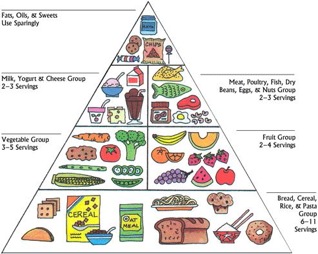
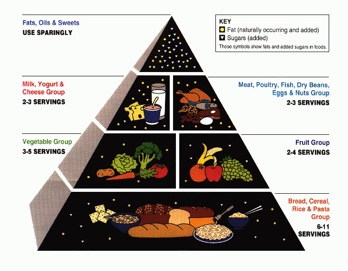
Box 2
‘Food Guide Pyramids’: My view
‘Food Guide Pyramids’ of the type issued by governments, their agencies, and thus by health professional organisations at all levels from national to local, are at best confusing, and at worst are damaging to public health.
My point is made by the two Pyramids above. These are two versions of the ‘classic’ Pyramid issued by the US Department of Agriculture, the relevant ministry of the US federal government, at first in 1992. They are adaptations and developments of ‘Food Group’ guides issued in the US, the UK and other countries since early last century. Although now superseded in the US by the equally problematic ‘MyPyramid’, they remain a basis for nutrition education in many countries.
As you can see, these Pyramids muddle together fresh and minimally processed foods, processed ingredients, and ultra-processed products. This is most evident in the base section of the pyramids, which display and promote starchy foods, recommended to be consumed abundantly, in amounts higher, and usually much higher, than is typical in any higher-income country. The visuals used as examples include bowls of rice and dishes of pasta; packets of oatmeal and of ready-to-eat breakfast cereal; breads; and cupcakes, buns and crackers, as if these are roughly equivalent in value. They are not. For example, grains such as rice, and also roots and tubers such as cassava (manioc) and potatoes, when consumed after being boiled or steamed, have an energy density and general nutritional value very different from that of bread and of baked fatty or sweetened or salty products such as cupcakes, buns and crackers
All types of guide to food and nutrition, including graphic guides like the ‘Food Guide Pyramid’, are now misleading and unhelpful. The only useful guides are those based on the nature, extent and purpose of processing. It is time to demolish the Pyramid.
A very short history of dietary guidelines
Until the second half of the 20th century, beginning in industrialised countries and their colonies, and until recently in low-income countries, the main purpose of dietary recommendations has been to encourage adequate consumption of energy (calories), of protein, and also of various micronutrients, in order to promote growth and strength in infancy, childhood and early life, and to prevent undernutrition and other deficiencies. ‘Food groups’ were devised. These included meat and fish, and also as a separate group milk and dairy products (for protein, and calcium); vegetables and fruits (for vitamins and minerals); and fatty, sugary and starchy foods (for fat, carbohydrate, energy). Such food guides have been strongly promoted at times of threatened food insecurity, including in Europe in and around both World Wars.
As from the 1960s this all changed. Since then, the main purpose of most prominent dietary recommendations has been to prevent overconsumption, either in general, or of specific macronutrients or types of food generally agreed to be a cause of various chronic diseases. Fatty and sugary foods were no longer recommended, and guidelines issued by United Nations agencies, and various national governments, increasingly often recommended ‘top limits’ of amounts of fat, saturated fat and sugar, often expressed as percentages of total energy (calories). If only to ‘make up the numbers’ – less fat and sugar, with no change in protein and no recommendation on alcohol, must mean more of something else – guidelines have recommended consumption of a lot more starchy foods, and in particular grains (cereals) and cereal products. ‘Complex carbohydrates’ are often stressed, which implies more of any kind of bread. Starchy roots and tubers are often not much mentioned. In the US, very remarkably, potatoes and potato products such as French fries (chips) are classified as vegetables.
One rationale for promotion of grains and cereal products such as bread, is the general agreement since the 1980s that bulky high-fibre diets are good for gut health, and may protect against various diseases. The text of such recommendations often gives preference to ‘minimally processed’ or ‘high-fibre’ or ‘wholegrain’ versions. However, most bread produced and consumed in almost all countries is made from white flour, depleted of dietary fibre. The general impression, as graphically shown in the Pyramids above, has been and still is, to recommend all sorts of starchy foods, foods largely made from starchy ingredients, and other cereal products. One comment from a focus group as quoted by Marion Nestle, organised to elicit comments on the Food Guide Pyramid in draft stage was ‘You look at it, and you know you are supposed to eat more of the bread and cereal’ (4). In 1995, three years after its launch, US official dietary guidelines specified: ‘Use foods from the base of the Food Guide Pyramid as the foundation of your meals’ (4). This more or less remains one of the ‘master’ recommendations made in official and other authoritative dietary guidelines.
Box 3
Pyramid power
Geoffrey Cannon writes: The pyramid is a symbol of power and mystery. The US public affairs agency Porter Novelli, who beginning in 1988 did the original testing for the US Department of Agriculture of various graphic ways to recommend healthy food and nutrition, will certainly have thought of this.
Pyramids are associated with the Great Pyramids of Egypt (left, below), one of the Wonders of the World. Fittingly, there is enormous and popular speculation concerning what pyramids ‘mean’. In the US, one interpretation is to be found on the back of the 1 dollar bill (right, below).


The words above the apex and the ‘all-seeing eye’ are usually translated as ‘God favours our cause’. The words below say ‘The new world order’. The pyramid in the form shown is a Masonic symbol, representing the Temple of Jerusalem. (Whether the late 18th century designers of this part of the US Great Seal were deliberately promoting Freemasonry, is disputed). The ‘all-seeing eye’ has been used as a mystical symbol since ancient Egyptian religious iconography.
So what? Well, common sense, supported by a powerful symbol carried in the pockets and wallets of everybody in the US, is that the apex of a pyramid is the ‘best bit’ – the most precious place. This also is unlikely to have escaped the attention of many of those who favoured the Food Pyramid in the first place, and indeed now. In case you think this is fanciful, here below are two more Pyramids. The first, at left, is a graphic representation of the types and levels of scientific evidence that in the US and elsewhere are most favoured, and those that are least favoured. Laboratory including animal studies, and expert ideas and opinions, are regarded as weak or even useless evidence. Systematic reviews, meta-analyses and randomised controlled blinded trials (RCTs) of human groups are approved as strong evidence. And where do RCTs go? In the same place as the all-seeing eye shown on the 1 dollar bill pyramid – on top. This is also where ‘fats, sugars and sweets’ are placed.
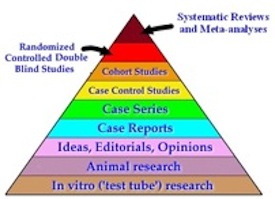
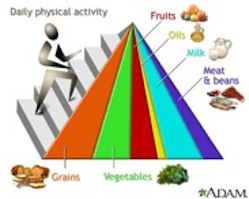
On the right, is the current US refurbished ‘MyPyramid’ This stresses physical activity, and replaces the ‘pyramid layers’ with strips indicating different types of food. ‘Grains’ (the orange strip on the left, now also showing sliced bread) is given some prominence. Also, the outline ‘runner’ is shown aspiring – to the top of the pyramid. Pyramids are powerful, for sure, but as symbols to represent healthy food and nutrition they are unhelpful, as everybody in the US who still uses money can see.
Seven reasons to demolish the Food Guide Pyramid
I am not the first nutrition scientist to question the Food Guide Pyramid. Walter Willett of the Harvard School of Public Health is a severe critic of general and specific US dietary recommendations as displayed in Pyramid form (5). Marion Nestle, chair of the department of nutrition and food studies at New York University for many years, is not against the Pyramid, but has published a trenchant critique (4).
In the US the Pyramid has now been deconstructed and then reconstructed as ‘My Pyramid’ – see above – to give less emphasis to food and instead to encourage physical activity. Other non-official and special-interest pyramids have been devised that promote or emphasise whole foods, plant foods, vegetarian and vegan diets, ‘low glycaemic index’ foods, foods high in protein, and so on.
Here are seven reasons why, from the point of view of public health, Food Guide Pyramids are not part of the solution, but part of the problem. The first two reasons are to do with the intrinsic nature of pyramids. The other reasons are to do with all current official dietary guidelines, however these may be graphically represented.
1 Pyramid power
The use of a pyramid is a distraction. It associates food and nutrition with a mystical symbol in ways that are irrelevant and distracting.
2 ‘Top’ means ‘best’
The top, tip or apex of any structure is generally seen as its most valuable and attractive part. Notwithstanding what Food Pyramids (or triangles) say in their accompanying text about fats, oils and sugars, the visual impression is that these are ‘the best bit’.
3 Graphics are hopelessly selective
Graphic representations of dietary recommendations have to be very selective. Also, they are hangovers from the time when most foods were purchased whole or as ingredients, with some modern additions like yoghurts and packaged milk. Many of the pictures in Food Guide Pyramids roughly correspond to some of the foods people purchased and prepared for consumption at home half a century ago. Apart from fresh vegetables and fruits, most do not look like what people actually buy now.
4 Food groups are unhelpful
‘Food Groups’, originally devised nearly a century ago, are agreed after negotiation with powerful sectors of industry, which in the US, the UK and other countries include producers and manufacturers of meat and meat products, and of milk and dairy products (4).The milling and baking industries are also powerful. The emphasis on meat, milk and bread in ‘Food Groups’, has always followed industry pressure, usually backed by nutritional rationales. There has also been a tendency to ‘export’ groupings of food devised in and for temperate high-income countries to tropical or lower-income countries, whose original or established food systems are – or have been – different. The Food Guide Pyramid is also ‘imported’ without much or even any adaptation, by countries whose native and established foods are often different from those displayed on the Pyramid.
5 The main issue is not nutrients
Food Guide Pyramids are descended from graphic groupings of foods seen to be relatively good sources of protein, carbohydrate, fat, vitamins or minerals. This equation of food with its chemical composition has always had limited value. This ‘nutritionism’ is more valuable to industry than to public health. A conspicuous example is the ‘carbohydrate’ grouping. This includes whole starchy foods and refined sugary foods, which have dramatically different nutritional value and metabolic effects. Grouping in terms of nutrients now is increasingly useless, as manufacturers manipulate formulations of basically worthless products to make them seem ‘healthy’.
6 The main issue is not foods
Food-based recommendations make more sense than nutrient-based recommendations. But for example, what is ‘meat’? Is a cheese-and-bacon burger, the ‘icon’ of these commentaries, ‘meat’? Or is it ‘cheese’? Or does its bun place it in the ‘bread’ group? Or is deconstruction the answer, so that to take another example, pre-cooked ready-to-heat spinach lasagne figures in the ‘vegetable’, and the ‘pasta’ and also the ‘fats, oils and sweets’ groups? Is apple pie ‘fruit’ or ‘cereal’ or ‘fats, oils and sweets’? What about ready-to-eat breakfast cereals, positioned in the bottom of the Pyramid as a basic food? Should those varieties with 40 per cent of calories in the form of sugars also figure in the ‘fats, oils, and sweets’ layer, as a form of candy (confectionery)? And what about pastries, chocolate cake, and cookies (biscuits), that are not shown on Pyramids? The designers of the lower Pyramid shown above seem to be aware of such basic problems, for its apex represents ‘fats, oils and sweets’ by what look like snowflakes. And do the designers of Food Guide Pyramids really believe there is not much significant difference between boiled rice, pasta, uncooked oatmeal, all types of bread, any type of breakfast cereal, cupcakes, buns, and crackers?
7 The main issue is processing
To realise that Food Guide Pyramids are confusing and misleading, look at what they show, then look at what is in the shops, and try to relate one to the other. Unless you avoid almost all but fresh and the most simply packaged food and drink, it’s impossible. The only really meaningful distinctions are between fresh and minimally processed foods; culinary ingredients; and ultra-processed products. As a guide for populations, the Pyramid does not and cannot work.
How to group food
Graphics can be used to group food according to the nature, extent and purpose of its processing. But I am inclined not to use any fancy design like a pyramid, plate, circle, pot or rainbow. These are all too simplistic and usually tendentious. Here is what I propose. It is a simple colour-coded list, adapting the tables shown in my first commentary (2), with general recommendations.


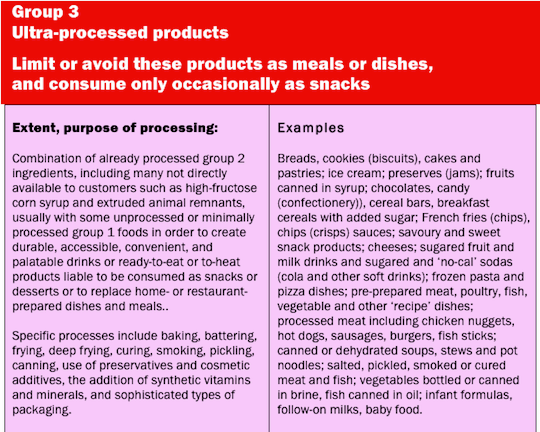
This is work in progress
The lists above are not complete. All new suggested recommendations shown here at this stage amount to work in progress. Comments and suggestions will be very welcome – please use the response facility at the foot of this commentary. Terms like ‘plentifully’, ‘avoid’, ‘limit’ and ‘occasionally’ need to be quantified. Also, the top advisable limits of consumption of ultra-processed products need to be identified. This will follow more research into trends of consumption and also of overweight, obesity and related diseases in various countries. This work is planned and will be done.
References
- Instituto Brasileiro de Geografia e Estatistica. Pesquisa de orçamentos familiares 2008-2009 - Antropometria e estado nutricional de crianças, adolescentes e adultos no Brasil. Rio de Janeiro, IBGE, 2010.
- Monteiro C. The big issue is ultra-processing. [Commentary] World Nutrition, November 2010, 1, 6: 237-269. Obtainable at www.wphna.org
- Monteiro CA, Levy RB, Claro RM, Castro IRR, Cannon G. (2010). A new classification of foods based on the extent and purpose of food processing. Cadernos de Saúde Pública, 26 (12). [December]. [In press].
- Nestle M. Food Politics. Berkeley CA: University of California Press, 2002.
- Willett W. Eat, Drink and be Healthy. The Harvard Medical School Guide to Healthy Eating. New York: Free Press, 2001

Box 4
Bread My view
By definition, all types of bread are ultra-processed. However, I am not – emphatically, not – saying or suggesting that it is best always to avoid bread. Besides, ‘bread’ is a very broad term. It refers to degraded sliced ‘light’ white bread such as that shown above, as now most commonly manufactured and consumed in most countries where bread has become a common food. Such bread is unpalatable by itself, and is typically consumed as the package for sandwiches whose overall quality and value is usually practically the same as that of a burger. Sandwiches are not a good substitute for a proper meal.
The term also refers to artisanal ‘heavy’ wholegrain breads, usually made from wheat, but sometimes from corn or rye. Such breads are rich in various vitamins, minerals and dietary fibre. Rye bread is still commonly consumed in some central and northern European countries. (Tortillas, oatcakes and porridges are not defined as forms of bread). ‘Bread’ further refers to crusty loaves, baguettes, rolls, croissants, fancy breads and other traditional delights in wheat-growing and wheat-importing countries where local family bakeries are still in business and bread is bought daily.
Breads that are delicious consumed by themselves are a much better choice than bread that is only palatable as the outer parts of a sandwich or as the base of usually fatty or sugary spreads. Degraded white bread is not a good basis for any substantial meal, dish or snack. Prefer steamed or boiled grains, pasta, roots and tubers.
Why bread is ultra-processed
The definition of ‘ultra-processing’ used in these commentaries is: ‘Combination of already processed group 2 ingredients usually with some unprocessed or minimally processed group 1 foods, in order to create durable, accessible, convenient, and palatable drinks or ready-to-eat or to-heat products liable to be consumed as snacks or desserts or to replace home- or restaurant-prepared dishes and meals’. Processes involved include baking.
This makes bread an ultra-processed product (UPP). In this respect it is similar to, while much less fatty than, other products whose main single ingredient is flour, some of which are sugary, such as cookies (biscuits), cakes and pastries, cereal bars, breakfast cereals, pre-cooked pasta and pizza dishes, pot noodles, and cereal-based baby food. It is also similar to while much less fatty than starchy products such as French fries (chips) and chips (crisps).
Bread is different from, and far more energy-dense than, rice, corn, oats, millet and other grains, and pasta, and also unlike roots and tubers such as cassava (manioc) and potatoes, when these are prepared using steam or boiling water, and consumed as such as a substantial part of a meal.
A very short history of bread
For those brought up in a Christian, Jewish or Islamic tradition, bread has the very best sponsor: God. There are accounts of the making of bread in the Old Testament. Bread is called ‘the staff of life’. For Christians, the Lord’s Prayer includes ‘give us this day our daily bread’. The ‘breaking of bread’ is a symbol of communion, most powerfully expressed in the Last Supper, and thence the ceremony in which priests still give believers a token of bread as if it is the body of Christ.
Bread does not mean grains (cereals). It almost always means wheat. It is also made from rye, and a soft bread can be made from corn with the addition of wheat. But from its beginnings 6000 years ago in the ‘fertile crescent’ of the Middle East (1), the cultivation of wheat with its adhesive gluten, its grinding into flour, and its baking into bread, usually leavened with yeast, created classes of growers, artisans and traders, and provided the main source of sustenance for populations which rapidly formed into cities. Bread is also part of the story of power, empire and capitalism. Mills required substantial investment and protection, grain and flour can be hoarded, and rulers can control supply. The rulers of Rome stopped the plebs becoming mobs with panem et circenses – bread and circuses. From the days of ancient Egypt to the time of the French Revolution and even now, riots of starving populations in wheat-growing countries often centre on the availability and price of bread.
Until recently in history, bread was unknown to most people in most of the world. Their basic staple foods have been and often still are made from other grains (cereals) such as many strains and varieties of rice, corn, rye, oats or millet, or from plantains, or from roots or tubers such as cassava (manioc), yams, and potatoes. These all provide basic foods that are fundamentally different from and far less energy-dense than bread, because they all are typically made palatable, after various forms of preparation, simply by boiling or steaming. They are then served as such, as a main part of meals, or in the form of porridges or gruels. Corn is an exception when it is made into tortillas, which are roughly equivalent to unleavened bread.
Wheat is the natural grain (cereal) only in some parts of the world. Nevertheless, heads of wheat are often used as a universal symbol of food, including by the Food and Agriculture Organization of the United Nations. Wheat increasingly became the ‘master grain’ and bread the ‘master food’, as a result of the conversion beginning in the mid-19th century of vast tracts of North American prairie to wheat, and then by the invention of methods of milling, and much later of baking, that enable mass production of cheap bread made from white flour. In Britain, wheat has displaced oats, rye and barley, all of which were once common crops. The ‘Green Revolution’ is of strains of hybrid short-stem wheat requiring substantial chemical inputs that have displaced native varieties of wheat, and also of rice, in India and elsewhere.
Pre-slicing and packaging technology turns an already degraded ultra-processed product into ‘envelopes’ for sandwiches made at home, or for sale in snack bars. This has resulted in cheap low-quality bread becoming increasingly dominant in most countries, including those in which wheat is not grown or is not a natural crop.
Box 5
Sandwiches
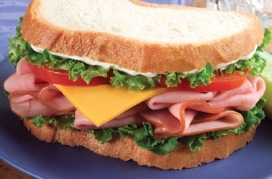
Because bread of all types has a ‘healthy’ image, it is popularly supposed that whereas burgers are unhealthy, sandwiches are healthy. But if you look at this picture, of a cheese and ham sandwich with lettuce, the bread no doubt spread with some table fat, and then look at the ‘icon’ bacon-cheeseburger at the beginning of this commentary, you can immediately see that such an idea has to be nonsense.
Burgers are warm whereas sandwiches are cold, and processed meat in the form of a meat patty might be considered inferior to processed meat in the form of ham, as might tomato sauce compared with tomatoes. But in most respects the products are the same. In this picture here the bread used, while white, looks firm and cut from a loaf with a crust. Most sandwiches made at home or sold in shops use uniform degraded cheap pre-sliced soggy, floppy products.
As stated in the main text below, bread itself averages 225-275 calories every 100 grams, and therefore is by itself fairly energy-dense – more so than avocados, say, or thicker types of French fries (chips), or meat unless it is fatty. When combined with chicken, or tuna, or ham, all of which are usually somewhat less energy-dense, but maybe plus cheese, and with the bread spread with table fat, the sandwich’s total energy density per 100 grams somewhat increases, and is usually much the same or even a bit higher than most types of burger. If mayonnaise or some other fatty sauce is added, the energy density of a sandwich will increase to perhaps close to 300 calories per 100 grams, roughly the same energy density as sausages, condensed milk, greasy snacks, black forest gateau, or Christmas pudding.
An average sandwich weighs around 160 grams, and so delivers around 350-500 calories. The equivalent of a Big Woppa, like the one here, or a Subway sandwich, might weigh in at 200-250 grams, which makes 450-750 calories. This is roughly between one-quarter and one-third of the daily energy turnover of a basically sedentary adult. The bottom line, is that sandwiches are just as likely to deliver excess calories as burgers. Transnational burger companies are troublesome in a number of ways, such as impact on forests, reliance on cows, penetration of lower-income countries, and poor employment conditions. But nutritionally, there is no substantial difference between standard sandwiches and standard burgers
Seven objections to bread
I am far from being the first nutrition scientist to question the value of bread. Most critics make a sharp distinction between wholegrain bread, which is a good source of dietary fibre and various vitamins and minerals, and bread made from white flour, which is depleted of fibre and micronutrients (some of which may be added as so-called ‘enrichment’), and which may contain problematic preservatives and other additives. Between white bread and wholegrain bread, wholegrain is indeed by far the better choice. Good quality bread is a good side accompaniment to a meal. But important objections are to all forms of bread, particularly when eaten as the wrapping for sandwiches that replace proper meals. The objections are direct, and also indirect inasmuch as wheat and bread displace more suitable crops and better foods. Bread is not a good choice as a staple food, and sandwiches are not a good alternative to proper meals. The first reasons given here are nutritional. I also give broader social, cultural, economic and environmental reasons.
1 Bread by itself is fairly energy-dense
The energy density of bread varies, but not by much. Most breads deliver between 225 and 275 calories per 100 grams. This makes bread more energy-dense than most meat unless it is fatty, more energy-dense than thick French fries (chips), roast potatoes, and ice-cream, and well over twice as energy-dense as rice, oats, pasta and other grains, and starchy roots and tubers, when these are made ready to eat by boiling or steaming. Bread is far more energy-dense than vegetables and fruits, including olives, and even than avocados. The main reason for the difference is that bread is relatively dry. Toasting and crisping increases energy density. Bread of itself, eaten as usually recommended as an everyday food, and as the wrapping for sandwiches in place of proper meals, will tend to make sedentary people overweight. (‘Fancy’ breads made with additional fat are more energy-dense, at around 300-400 calories per 100 grams. Most cookies (biscuits) are very energy-dense, at around 400-500 calories per 100 grams).
2 Bread is salty
Almost all bread is salty. Typically, bread contains around half a gram of sodium in every 100 grams, added in its manufacture. If eaten regularly, bread alone will supply more salt than the body needs. By contrast, all grains (cereals), roots and tubers contain very little sodium. This can of course be added in preparation and cooking, or at table, but as a matter of choice and in different amounts.
3 Most bread is not eaten by itself
Bread is promoted as a healthy product. In fact, almost all bread is made from degraded white flour, depleted of dietary fibre and micronutrients. But in any case, such cheapened bread is not palatable by itself. It is typically used as an edible wrapping for sandwiches with variable nutritional quality, whose energy-density, total calories and other qualities are much the same as burgers. (See Box 5, above).
4 Much of the profit in bread is in what is removed from it
Modern milling machinery makes white flour, which is a technically a more suitable basis for mass manufactured bread. The milling process separates and removes the germ and the bran of wheat. This makes better business. Bran is sold for animal feed and as a human laxative, and germ is sold as a ‘health food’ – which indeed it is. The giant millers and bakers have for over half a century made spurious claims that white bread is highly nourishing, not because it actually is, but because it makes more money. Health claims for white bread have been boosted by statutory or voluntary additions of B vitamins, or calcium, or dietary fibre.
5 Bread displaces better staple foods
Wheat is very big business in powerful countries, including the US (and Canada), and Russia. The wheat crop is important to the national economy of such countries, and is liable to be massively protected with subsidies. The result is that the most commercially profitable forms of degraded white bread become very cheap, and tend to displace rice, oats, barley, millet, pasta, roots or tubers as staple foods. As a result the energy-density of food supplies and thus diets will increase. As two examples, boiled potatoes and cassava (manioc) are around 75 calories per 100 grams, and boiled rice and pasta are around 140-150 calories per 100 grams. The energy density of meals and dishes using these as bases is liable to be a lot lower than bread or sandwiches, unless a lot of oil is used. Porridge oats is 50 calories per 100 grams made with water, 120 if made with whole milk.
6 Wheat displaces better crops
Wheat is one of the best crops in those parts of the world where it naturally grows, or can be readily cultivated. In most parts of the world it cannot be grown successfully, or is not a natural crop, and so has not been a part of traditional and established food systems. In the Americas the original crop was, and often remains, corn. In many parts of Asia the established crop is rice, traditionally grown in paddies together with fish. In other parts of the world other grains, or else plantains, roots or tubers, have been and often still remain the staple foods. For example cassava (manioc) has been and remains a vital crop for subsistence farmers in South America and then in Africa and some parts of Africa, because the starchy roots can be left in the ground as a natural storehouse for long periods of time. But increasingly, wheat, or to be more precise those strains of wheat that grow fastest or are most suitable for breadmaking, is increasingly becoming the global ‘master grain’. This process is largely driven by the commercial interests of very big international business, boosted by subsidies. This is unnatural, unfair, and destructive, and is also dangerous, because of the effects of depleted biodiversity.
7 Bread ruins established cultures and local economies
In Central America, native corn is part of traditional religion, as is native rice in many parts of Asia. Traditional food systems, culture and cuisines are usually centred on native and established staple crops that are suitable in specific climates and terrains. For pre-industrial people, food is far more meaningful than it is to most people now living in cities. The importation of wheat and bread into parts of the world where this crop and food have been until recently unknown or uncommon, has a damaging and even devastating effect on traditional food ways. Further, native food systems in parts of the world where food is relatively hard to find or grow, are liable to be fragile. Their displacement by any form of ‘store food’, particularly when it is durable and cheap, like white flour, or cheapened bread, can cause dependence and even the fragmentation of established food systems. This is more generally true, when as is increasingly happening, cooperative and family corn and rice farmers find that their price of their crops are undercut by artificially cheap imported corn and rice – and also wheat, in the form of cheap degraded white sliced bread.
Reference
- Jacob H. Six Thousand Years of Bread. Its Holy and Unholy History. Garden City NY: The Lyons Press, 1997. Originally published 1944.
Acknowledgement and request
Readers are invited please to respond. Please use the response facility below. Readers may make use of the material in this editorial if acknowledgement is given to the Association, and WN is cited
Please cite as: Monteiro C. The big issue is ultra-processing. ‘Food Guide Pyramids’, and what’s the problem with bread. [Commentary] World Nutrition, January 2011, 2, 1: 22-41. Obtainable at www.wphna.org
The opinions expressed in all contributions to the website of the World Public Health Nutrition Association (the Association) including its journal World Nutrition, are those of their authors. They should not be taken to be the view or policy of the Association, or of any of its affiliated or associated bodies, unless this is explicitly stated.
WN commentaries are subject to internal review by members of the editorial team. This commentary was reviewed by Geoffrey Cannon and Fabio Gomes.
CAM states: This commentary was drafted and revised following many discussions. Geoffrey Cannon drafted the boxed texts for revision and approval by me. I have relied on his historical knowledge, and his experience as consultant first to the UK and then the Brazilian governments. I regard him as my co-author. I have learned from the work of Michael Pollan, David Ludwig, Kelly Brownell, Marion Nestle and their colleagues and sources. Information on the development of the Food Pyramid in the US comes partly from Marion Nestle’s book Food Politics; many thanks. All the ‘ultra-processing’ commentaries have benefited from discussions I have had in the last two years or so with my Brazilian colleagues Inês Castro, Renata Bertazzi-Levy, and Rafael Claro, and also with Geoffrey Cannon and Fabio Gomes, who are all co-authors with me of other papers, published and in preparation. They share authorship with me of the ‘ultra-processing’ concept and its expression as shown here. The main ideas underlying the different nature of different types of industrial food processing, and the mechanisms linking ultra-processed foods and human health, as shown in the text and tables here, have been developed with their help. I have no conflicts of interest.






